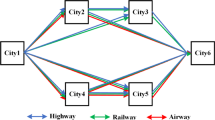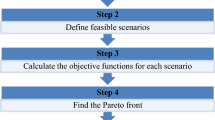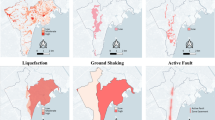Abstract
Aiming to provide a generic modeling framework for finding stop plan and tickets allocation of high-speed railway, we first propose a stop plan and tickets allocation collaborative optimization model in this paper, which is established to maximize the passenger satisfaction degree and the average seated occupancy rate. Due to the randomness and uncertainty of passenger demand, uncertain variables are set and the primal model is an uncertain model. And then, the model is transformed into equivalent deterministic model based on uncertainty theory. Because of the computational complexity of the model, especially for the large-scale real-world instances, we develop a Lagrangian relaxation (LR-based) heuristic algorithm that decomposes the primal problem into two sub-problems and thus is able to find good solutions in short time. Finally, a numerical experiment based on the operation data of high-speed railway from Beijing south Station to Shanghai Hongqiao Station is implemented to verify the effectiveness and feasibility of the proposed approaches.



Similar content being viewed by others
References
Bum HP, Kimz CS, Rhox HL (2010) On the railway line planning models considering the various halting patterns. Lecture Notes in Engineering and Computer Science 2182(1)
Bum HP, Seo YI, Hong SP, Rho HL (2013) Column generation approach to line planning with various halting patterns—application to the Korean high-speed railway. Asia Pac J Oper Res 30(4):123–142
Cacchiani V, Furini MK (2016) Approaches to a real-world train timetabling problem in a railway node. Omega 58:97–110
Dauzère-Pérès S, Almeida DD, Guyon O, Benhizia F (2015) A lagrangian heuristic framework for a real-life integrated planning problem of railway transportation resources. Transp Res Part B 74:138–150
David C, Eva B, Gilbert L, Francisco A (2016) A short-turning policy for the management of demand disruptions in rapid transit systems. J Railw Sci Eng 246(1–2):145–166
Deng LB, Zhu YG (2013) Uncertain optimal control of linear quadratic models with jump. Math Comput Modell 57(9–10):2432–2441
Ding SB (2013) Uncertain multi-product newsboy problem with chance constraint. Appl Math Comput 223:139–146
Everett H III (1963) Generalized Lagrange multiplier method for solving problems of optimum allocation of resources. Transp Sci 11:399–417
Falk JE (1969) Lagrange multipliers and nonconvex programs. SIAM J Control 7(4):534–545
Fan ZP, Ni SQ, Chen DJ (2012) The collaborative optimization of stop plan with train working diagram of high-speed railway passenger trains. In: International conference of logistics engineering and management, pp 152–156
Fu HL, Nie L, Benjamin RS, He ZH (2012) Train stop scheduling in a high-speed rail network by utilizing a two-stage approach. Math Probl Eng 4:123–132
Fu HL, Benjamin RS, Nie L (2013) Operational impacts of using restricted passenger flow assignment in high-speed train stop scheduling problem. J Railw Sci Eng 4:1–8
Fu H, Nie L, Meng L, Sperry BR, He Z (2015) A hierarchical line planning approach for a large-scale high speed rail network: the China case. Transp Research Part A: Policy Pract 75:61–83
Gao Y (2011) Shortest path problem with uncertain arc lengths. Comput Math Appl 62(6):2591–2600
Gao Y (2012) Uncertain models for single facility location problems on networks. Appl Math Model 36(6):2592–2599
Gao Y, Wen ML, Ding SB (2013) The (s, s) policy for uncertain single-peorid inventory problem. Int J Uncertain Fuzziness Knowl-Based Syst 21(6):945–953
Geoffrion AM (1974) Lagrangean relaxation for integer programming. Math Program Study 2:82–114
Ghoseiri K, Szidarovszky F, Asgharpour MJ (2004) Design and evaluation on operational plan of express and local trains for urban rail transit. J Railw Sci Eng 15(1):233–239
Goossens JW, Hoesel S, Leo K (2002) On solving multi-type line planning problems. Res Memo 168(2):403–424
He Z, Nie L, Fu H (2014) Service planning system for large-scale high speed railway network. J Softw 9(5):1121–1128
Jan WG, Hoesel S, Leo K (2006) On solving multi-type railway line planning problems. Eur J Oper Res 168(2):403–424
Joo JH, Kim KM, Oh SM, Lim KM, Park OS (2017) Station capacity calculation on high-speed railway considering the number of sidings and train halting patterns. J Korean Soc Railw 20(8):539–549
Lemaréchal C (2001) Lagrangian relaxation. Springer, Berlin
Liu BD (2007) Uncertainty theory, 2nd edn. Springer, Berlin
Liu BD (2009) Some research problems in uncertainty theory. J Uncertain Syst 3(1):3–10
Liu BD (2010) Uncertainty theory: a branch of mathematics for modeling human uncertainty. Springer, Berlin
Qi JG, Yang LX, Di Z, Li SK, Yang K, Gao Y (2018) Integrated optimization for train operation zone and stop plan with passenger distributions. Transp Res Part E Logist Transp Rev 109:151–173
Qiang LX, He ZH (2017) Study on train ticket allocation based on passenger flow assignment technology. Railw Transp Econ 39(9):7–11
Qin ZF, Kar S (2013) Single-period inventory problem under uncertain environment. Appl Math Comput 219(18):9630–9638
Ralf B, Martin G, Marc EP (2007) A column-generation approach to line planning in public transport. Transp Sci 41(1):123–132
Roberto S, Jose LM, Ruben C, Angel I (2017) Optimal stopping location of a high speed train using GIS and multicriteria decision-making. Transp Res Part B 21(1):151–168
Song WB, Zhao P, Li B, Wang P (2017) High-speed railway ticket allocation considering passenger travel time. J Southeast Univ 47(5):1062–1068
Sun YG, Ran XC, Yang FH, Chen SK (2018) Design and evaluation on operational plan of express and local trains for urban rail transit. J Railw Sci Eng 15(1):233–239
Xie WJ, Ouyang YF (2016) Reliable location-routing design under probabilistic facility disruptions. Transp Sci 50(3):1128–1138
Yang LX, Zhou XS, Gao ZY (2014) Credibility-based rescheduling model in a double-track railway network: a fuzzy reliable optimization approach. Omega 48(10):75–93
Yang LX, Qi JG, Li SK, Gao Y (2015) Collaborative optimization for train scheduling and train stop planning on high-speed railways. Omega 246(1–2):145–166
Yin JT, Yang LX, Tang T, Gao ZY, Ran B (2017) Dynamic passenger demand oriented metro train scheduling with energy-efficiency and waiting time minimization: mixed-integer linear programming approaches. Transp Res Part B 97:182–213
Yu HC, Chung HY, Ching CS (2000) A multi objective model for passenger train services planning: application to taiwan’s high-speed rail line. Transp Res Part B 34(2):91–106
Zhang B, Peng J (2012) Uncertain programming model for chinese postman problem with uncertain weights. Ind Eng Manag Syst 11(1):18–25
Zhang X, Fu H L, Tong L (2014) Optimizing the high speed train stop scheduling using flexible stopping patterns combination. In: IEEE 17th international conference on intelligent transportation systems (ITSC), pp 2398–2403
Zhang B, Peng J, Li S, Chen L (2016) Fixed charge solid transportation problem in uncertain environment and its algorithm. Comput Ind Eng 102(C):186–197
Zhang LQ, Nie L, Fu HL, Han PW (2017) Optimization model for high-speed railway line planning during holidays. Railw Transp Econ 39(11):57–66
Acknowledgements
This study was funded by the Fundamental Research Funds for the Central Universities (No. 2018YJS044), the Fundamental Research Funds for the Central Universities (No. 2018JBM019), and National Key R&D Program of China (No. 2018YFB1201401).
Author information
Authors and Affiliations
Corresponding author
Ethics declarations
Conflict of interest
The authors declare that they have no conflict of interest.
Ethical approval
This article does not contain any studies with human participants performed by any of the authors.
Informed consent
Informed consent was obtained from all individual participants included in the study.
Additional information
Communicated by X. Li.
Publisher's Note
Springer Nature remains neutral with regard to jurisdictional claims in published maps and institutional affiliations.
Appendix A: Uncertainty theory
Appendix A: Uncertainty theory
Uncertainty theory provides an axiomatic system to deal with the imprecise information in experts’ empirical data. Similar to probability theory, an event is denoted by a set with a designated nonnegative value, which indicates the occurrence possibility of the event. Different from that in probability theory, the occurrence possibility is obtained by the judgement of experts other than historical or experimental data. There are some fundamental concepts and properties in Uncertainty theory.
Let \(\varGamma \) be a nonempty set and L is a \(\sigma \)-algebra over \(\varGamma \). Each element \(\varLambda \)\(\in \)L is designated a number \(M\{\varLambda \}\). In order to ensure the set function \(M\{\varLambda \}\) has certain mathematical properties, the following four axioms were presented (Liu 2007, 2009):
Axiom 1
(Normality) \(M\{\varLambda \}=1\).
Axiom 2
(Self-duality) \(M\{\varLambda \} + M\{\varLambda ^c\}=1\) for any event \(\varLambda \).
Axiom 3
(Countable subadditivity) For every countable sequence of events \(\{\varLambda _i\}\), we have
Axiom 4
(Product Axiom) Let (\(\varGamma _i, L_i, M_i\)) be uncertainty spaces for \(i=1, 2, \ldots , n\). Then, the product uncertain measure M is an uncertain measure on the product \(\sigma \)-algebra \(L_1\times L_2 \times \cdots \times L_n\) satisfying
The set function \(M\{\varLambda \}\) is called an uncertain measure if it satisfies the first three axioms. Simply speaking, uncertain measure \(M\{\varLambda \}\) is just the occurrence possibility of event \(\varLambda \), which is from experts’ evaluation. Based on the axioms, the concept of uncertain variable was proposed, whose mathematical properties can also be deduced.
Definition 1
(Liu 2007) An uncertain variable is a measurable function \(\xi \) from an uncertainty space (\(\varGamma , L, M\)) to the set of real numbers, i.e., for any Borel set B of real numbers, the set \(\{\xi \in B \}=\{\gamma \in \varGamma \vert \xi (\gamma )\in B\}\) is an event.
Similar to the random variable, the distribution of an uncertain variable \(\xi \) is defined by \(\varPhi (x)=M\{\xi \le x\}\) for any real number x. For example, the zigzag uncertain variable \(\xi \sim Z(a, b, c)\) has an uncertainty distribution \(\varPhi (x)\), which is shown in Fig. 4.
Definition 2
(Liu 2010) An uncertain variable \(\xi \) with distribution \(\varPhi \) is said to be regular, if its inverse function \(\varPhi ^{-1}(\alpha )\) exists and is unique for each \(\alpha \in (0, 1)\).
According to Definition 2, zigzag uncertain variable Z(a, b, c) is a regular variable, whose inverse distribution function is \(\varPhi ^{-1}(\alpha )\), i.e.,
Obviously, if \(\xi \) is regular, the distribution function \(\varPhi (x)\) is continuous and strictly increasing at each point x with \(0<\varPhi (x)<1\). Meanwhile, \(\varPhi ^{-1}(\alpha )\) is continuous and strictly increasing for \(\alpha \in (0, 1)\). We usually assume that all uncertain variables in practical applications are regular. Otherwise, a small perturbation can be imposed to obtain a regular one. Next, we introduce an operational law for regular uncertain variables.
A real function \(f(x_1, x_2, \ldots , x_n)\) is said to be strictly increasing if f satisfies the following conditions:
- (1)
\(f(x_1, x_2, \ldots , x_n)\)\(\ge \)\(f(y_1, y_2, \ldots , y_n)\) when \(x_i \ge y_i\) for \(i = 1, 2, \ldots , n\).
- (2)
\(f(x_1, x_2, \ldots , x_n)\)\(> f(y_1, y_2, \ldots , y_n)\) when \(x_i > y_i\) for \(i = 1, 2, \ldots , n\).
Given a strictly increasing function, Liu (2010) and Ding (2013) independently proved the following operational law for regular variables, which makes uncertainty theory efficient in monotonic system.
Theorem 1
Let \(\xi _1, \xi _2, \ldots , \xi _n\) be independent uncertain variables with regular uncertainty distributions \(\varPhi _1, \varPhi _2, \ldots , \varPhi _n\), respectively, and let f be a continuous and strictly increasing function. Then, the uncertain variable \(\xi =f(\xi _1, \xi _2, \ldots , \xi _n)\) has an inverse uncertainty distribution, i.e.,
Rights and permissions
About this article
Cite this article
Han, B., Ren, S. Optimizing stop plan and tickets allocation for high-speed railway based on uncertainty theory. Soft Comput 24, 6467–6482 (2020). https://doi.org/10.1007/s00500-019-04617-9
Published:
Issue Date:
DOI: https://doi.org/10.1007/s00500-019-04617-9





